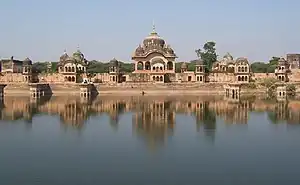Braj | |
|---|---|
     top to bottom: Radha Krishna at Kirti Temple, Barsana,
Krishna Janmasthan in Mathura, Radha Rani Temple in Barsana, Prem Mandir in Vrindavan and Kusum Sarovar in Govardhan Hill. | |
| Country | |
| Region | Northern India |
| Proposed capitals | Noida, Agra |
| Proposed Districts | |
| Language | Braj Bhasha dialect of Hindi |
Braj, also known as Vraj, Vraja, Brij or Brijbhumi, is a region in India on both sides of the Yamuna river with its centre at Mathura-Vrindavan in Uttar Pradesh state encompassing the area which also includes Palwal and Ballabhgarh in Haryana state, Deeg, Bharatpur, Karauli, and Dholpur in Rajasthan state and Morena District in Madhya Pradesh.[1] Within Uttar Pradesh, it is very well demarcated culturally, the area stretches from the Mathura, Aligarh, Agra, Hathras and districts up to the Farrukhabad, Mainpuri and Etah districts.[2] Braj region is associated with Radha and Krishna who according to scriptures were born in Barsana and Mathura respectively.[3][4] It is the main centre of Krishna circuit of Hindu pilgrimage.[1]
It is located 150 km south of Delhi and 50 km northwest of Agra.[1]
Etymology
The term Braj is derived from the Sanskrit word vraja (व्रज).[4][5] Vraja was first mentioned in Rigveda, and in Sanskrit it means a pasture, shelter or resort for cattle from the Sanskrit term "vraj" which means "go" in English.
Braj pilgrimage circuits
Since this is a site associated with the Vedic era, Lord Krishna and Mahabharata, it is an important place of pilgrimage for Hindus. It is one of the three main pilgrimage sites related to Krishna circuit, namely 48 kos parikrama of Kurukshetra in Haryana state, Vraja Parikrama in Mathura in Uttar Pradesh and Dwarka Parikrama (Dwarkadish yatra) at Dwarkadhish Temple in Gujarat.
The Braj Yatra circuit of pilgrimage was formally established by the 16th-century sadhus of the vaishnava sampradaya with fixed routes, itinerary and rituals. The area the circuit covers is spread across 2500 km2 with 84 kos or 300 km long periphery extending 10 km to the east and 50 km to the north and west. Braj has two main types of pilgrimage circuits, the traditional longer Braj Yatra encompassing the whole circuit, and the other shorter significantly modified contemporary point-to-point pilgrimage to visit the main sites at Mathura, Vrindavan, Gokul, Govardhan. The former, longer traditional pilgrimage route, also includes additional sacred sites Nandgaon and Barsana with travel on foot.[1]
See also
- Regional
- Braj language
- Vajji, the ancient region of the Vṛji janapada that Bajjika evolved from
- Religious
- Vedic era
- General
- Kingdoms of Ancient India
- Regions of Haryana
- Regions of Rajasthan
- Regions of Uttar Pradesh
References
- 1 2 3 4 Janet Cochrane, 2008, Asian Tourism: Growth and Change, page 249.
- ↑ Lucia Michelutti (2002). "Sons of Krishna: the politics of Yadav community formation in a North Indian town" (PDF). PhD Thesis Social Anthropology. London School of Economics and Political Science University of London. p. 49. Retrieved 20 May 2015.
- ↑ Lynch, Owen M. (31 December 1990), "ONE. The Social Construction of Emotion in India", Divine Passions, University of California Press, pp. 3–34, doi:10.1525/9780520309753-002, ISBN 978-0-520-30975-3
- 1 2 Lucia Michelutti (2002). "Sons of Krishna: the politics of Yadav community formation in a North Indian town" (PDF). PhD Thesis Social Anthropology. London School of Economics and Political Science University of London. p. 46. Retrieved 20 May 2015.
- ↑ Prasad, Dev (2015). Krishna: A Journey through the Lands & Legends of Krishna. Jaico Publishing House. ISBN 978-81-8495-170-7.
Further reading
- Rupert Snell, The Hindi Classical Tradition: A Braj Bhasa Reader. Includes grammar, readings and translations, and a good glossary.
